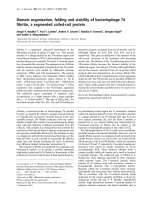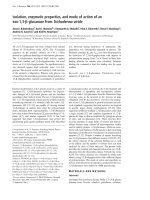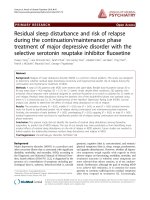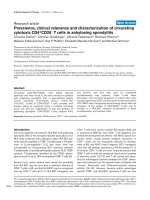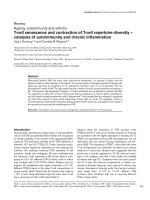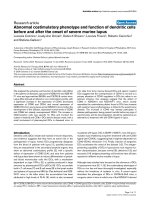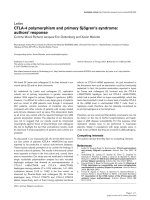Báo cáo y học: "Bench-to-bedside review: Biotrauma and modulation of the innate immune response" pps
Bạn đang xem bản rút gọn của tài liệu. Xem và tải ngay bản đầy đủ của tài liệu tại đây (73.08 KB, 8 trang )
280
ALI = acute lung injury; ARDS = acute respiratory distress syndrome; CXCR = CXC chemokine receptor; IL = interleukin; LPS = lipopolysaccha-
ride; MIP = macrophage inflammatory protein; MODS = multiple organ dysfunction syndrome; PEEP = positive end-expiratory pressure; PIP = peak
inspiratory pressure; PMN = polymorphonuclear neutrophil; Th = T-helper (cell); TNF = tumor necrosis factor; VILI = ventilator-induced lung injury;
Vt = tidal volume.
Critical Care June 2005 Vol 9 No 3 dos Santos et al.
Abstract
The innate immune network is responsible for coordinating the
initial defense against potentially noxious stimuli. This complex
system includes anatomical, physical and chemical barriers,
effector cells and circulating molecules that direct component and
system interactions. Besides the direct effects of breaching
pulmonary protective barriers, cyclic stretch generated during
mechanical ventilation (MV) has been implicated in the modulation
of the innate immunity. Evidence from recent human trials suggests
that controlling MV-forces may significantly impact outcome in
acute respiratory distress syndrome. In this paper, we explore the
pertinent evidence implicating biotrauma caused by cyclic MV and
its effect on innate immune responses.
Introduction
The natural or innate immune system is present in some form
in most living organisms and consists of mechanisms for
defending the host against foreign invaders and for healing
injured tissues. We now know that many of the mechanisms
of resistance to infection are also involved in the individual’s
response to noninfectious foreign substances and environ-
mental stresses, including mechanical stretch. Furthermore,
mechanisms that normally protect individuals and eliminate
foreign substances are themselves capable of causing tissue
injury and disease. This inherent defense network includes
anatomical, physical and chemical barriers, circulating
molecules, cells with specific phagocytic or lytic abilities, and
soluble mediators that orchestrate the activities of each
component and their interactions with the acquired immune
system. Normally, this is a well integrated system of host
defense and preservation of self-integrity, in which numerous
cells and molecules function cooperatively. However, dys-
regulation of the fine balance between proinflammatory and
anti-inflammatory stimuli may explain the pathophysiologic
processes that underlie syndromes such as sepsis and acute
lung injury (ALI) [1].
Although patients undergoing positive pressure mechanical
ventilation may have impaired lung function, and possibly
impaired systemic immune defenses by virtue of their
underlying lung pathology, further dysregulation of natural
defenses occurs in these patients. The presence of an
endotracheal tube bypassing natural upper airway defenses,
decrease or loss of coughing, paralysis of bronchial ciliae,
alterations in surfactant and phagocyte and epithelial
defensins – a critical first line antibacterial defense
mechanism – all contribute to impairment in host defense
[2–4]. Apart from the direct effects of breaching pulmonary
protective barriers, cyclic stretch generated during
mechanical ventilation has been implicated in the modulation
of the innate immune system. In this short review we revisit
some of the pertinent evidence exploring the relationship
between biotrauma caused by cyclic mechanical ventilation
and its effect on innate immune responses. This is not
intended to be a comprehensive and structured review of the
Review
Bench-to-bedside review: Biotrauma and modulation of the
innate immune response
Claudia C dos Santos
1
, Haibo Zhang
2
, Mingyao Liu
3
and Arthur S Slutsky
4
1
Clinical Associate and Post Doctoral Fellow, Departments of Medicine and Critical Care Medicine, St. Michael’s Hospital, and Inter-Departmental
Division of Critical Care, University of Toronto, Toronto, Ontario, Canada
2
Assistant Professor, Departments of Medicine and Critical Care Medicine, St. Michael’s Hospital, and Inter-Departmental Division of Critical Care,
University of Toronto, Toronto, Ontario, Canada
3
Professor, Departments of Medicine and Critical Care Medicine, St. Michael’s Hospital, and Inter-Departmental Division of Critical Care, University of
Toronto, Toronto, Ontario, Canada
4
Vice President of Research, Departments of Medicine and Critical Care Medicine, St. Michael’s Hospital, and Inter-Departmental Division of Critical
Care, University of Toronto, Toronto, Ontario, Canada
Corresponding author: Arthur S Slutsky,
Published online: 5 January 2005 Critical Care 2005, 9:280-286 (DOI 10.1186/cc3022)
This article is online at />© 2005 BioMed Central Ltd
281
Available online />topic, but a window into what is novel in the basic science
field of ventilator-induced lung injury (VILI) and what
challenges there are for the future.
Biotrauma and multiorgan failure
Patients with acute respiratory distress syndrome (ARDS)
have a serious form of ALI with a mortality rate of at least 30%
[5–8]. However, the vast majority of patients who die with
ARDS do not die from their pulmonary disease (hypoxia) but
rather from dysfunction of other organs, termed multiple organ
dysfunction syndrome (MODS) [9,10]. A number of animal
and clinical studies have shown that mechanical ventilation per
se can worsen pre-existing lung injury and produce VILI. This
topic has been the subject of a number of reviews [9–14]. The
spectrum of VILI includes not only air leaks and increases in
endothelial and epithelial permeability, but also increases in
pulmonary and systemic inflammatory mediators – a process
that has been termed ‘biotrauma’ [9,10].
Overdistension and shear stress forces generated during
some patterns of mechanical ventilation have been implicated
in the pathophysiology of the inflammatory response
associated with VILI [15–19]. Alterations in the levels of
various proinflammatory and anti-inflammatory mediators
secondary to mechanical injury may play a crucial role in
potentiating and/or propagating this systemic inflammatory
reaction, ultimately leading to MODS and death. The central
concept is that mediators originate in the lung and gain
access to the circulation where they potentially can exert
detrimental effects. There are several principal mechanisms
by which mediator release may occur after cyclic stretch:
stress failure of the alveolar epithelial–endothelial barrier
(decompartmentalization); stress failure of the plasma
membrane (necrosis); alterations in cytoskeletal structure
without ultrastructural damage (mechanotransduction); and
effects on vasculature independent of stretch or rupture.
Irrespective of the precise mechanism(s) of mediator release,
the clinical consequences may be devastating. The
cumulative evidence that implicates VILI as a direct causative
agent for MODS was recently reviewed [14,16].
‘Injurious’ mechanical ventilations strategies – large tidal
volume (Vt; usually >12 ml/kg) and zero positive end-
expiratory pressure (PEEP) in experimental conditions – in
previously injured lungs can promote the release of
inflammatory mediators in the lungs and worsen lung injury.
This is supported by evidence from in vitro cell-stretch
systems, from ex vivo lung models, and from in vivo models
of mechanical ventilation following lung lavage, aspiration, or
endotoxin administration [20–24]. Damage to normal
(noninjured) or injured lungs by the application of very high Vt
(30–40 ml/kg) or very high inspiratory pressures has also
been documented. (Detailed discussions of the possible
mechanisms of VILI are provided elsewhere [11,12,15,25].)
Clinical studies have also provided convincing evidence that
high Vt ventilation can lead to an increase in production of
inflammatory mediators in humans [26–28]. The clinical
significance of VILI became apparent after the ARDSNet
demonstrated that a ‘lung protective approach’ – lowering Vt
to 6 ml/kg (predicted body weight) – was associated with
increased survival in ARDS patients [28]. One of the possible
explanations for this is that ventilatory strategies that limit
overdistension attenuate the effects of biotrauma. Support for
this theory can be inferred from the decrease in plasma IL-6
levels in patients who were ventilated with the protective
strategy. Presumably, the lower IL-6 level in these patients
reflects a reduction in the proinflammatory response
secondary to decreased biotrauma to the lung. Ranieri and
coworkers further expanded on this hypothesis by
demonstrating that what was previously thought of as a
conventional ventilation strategy (12 ml/kg) can lead to an
increase in both local and systemic inflammatory mediators
[27], and that an increase in plasma IL-6 levels correlates
with the development of MODS [27,29].
Although there is no direct evidence to date that definitively
demonstrates that mediators generated in the lung can cause
MODS, injurious ventilatory strategies can lead to release of a
number of factors that could theoretically have an impact on
MODS, including translocation of bacteria, bacterial
products, or circulating proapoptotic factors [30–33]. In
support of the link between VILI and MODS, Imai and
coworkers [33] demonstrated that an injurious ventilation
strategy in animals with lung injury due to acid aspiration led
to apoptosis in the kidneys and small intestine. The authors
also found a significant correlation between changes in
soluble Fas ligand (a key mediator of cellular apoptosis) levels
and changes in creatinine in patients with ARDS involved in a
clinical trial of protective ventilation strategy. Further evidence
is required to determine whether the soluble Fas ligand
actually originated in the lungs. Irrespective of the source,
these findings may have important biologic and clinical
implications.
VILI can modulate polymorphonuclear
neutrophil function and innate immune
response to lipopolysaccharide and sepsis
The general strategy of innate immune detection is one in
which a limited number of receptors are dedicated to the
recognition of microbial molecules that are conserved across
broad taxa, and, for the most part, the receptors must be
indifferent to molecules of host origin (the basis of innate
immune discrimination between self and non-self) [34].
Recently, it has become apparent that the term ‘pathogen-
associated microbial pattern’ is a misnomer. In fact, it is not
microbial patterns that are recognized but rather specific
molecules, that are integral constituents of microorganisms
that are recognized, suggesting this system is highly
discriminatory [35,36]. Moreover, it is now evident that the
innate immune response can be be altered, enhanced or
suprressed. In small doses, lipopolysaccharide (LPS; a
primary component of Gram-negative bacteria) can render
282
Critical Care June 2005 Vol 9 No 3 dos Santos et al.
animals resistant to a subsequent pathogen challenge. LPS
has a strong adjuvant effect, and it is well known that certain
microbes enhance the response to a co-injected protein
antigen [37,38]. This is of primary importance to critical care
physicians because there is a growing body of evidence in
support of the theory that mechanical ventilation may
sensitize the innate immune system and that, in turn, the
innate immune system may sensitize the lungs to the effects
of mechanical ventilation. This ‘two-hit hypothesis’ has
permeated the literature on VILI and purported ensuing
MODS.
Pressure cycled ventilation can cause human alveolar
macrophages to release cytokines and proteases in vitro, and
the effect is amplified by bacterial LPS [39,40]. The ability of
cyclic stretch to modulate specific immune function is not
restricted to cells of myeloid origin [23]. In both alveolar
epithelial cells and bronchial epithelial cells, cyclic stretch
leads to increased expression of IL-8 [22,41]. Augmentation
of this response is seen with co-stimulation with tumor
necrosis factor (TNF)-α [42,43]. However, although the initial
inciting event (mechanical ventilation) may be injurious,
interaction between the innate immune system and
mechanical injury may be required for the development of the
full-blown lung injury phenotype of VILI.
Using a rat model of cecal ligation perforation, Herrera and
coworkers [44] found that animals ventilated with high Vt
(20 ml/kg for 3 hours) developed worse lung damage, higher
cytokine synthesis and release, and higher mortality rates.
Moreover, stabilizing alveoli in septic animals with PEEP
(presumably reducing atelectrauma) resulted in attenuation of
lung injury and reduced systemic and local inflammatory
response as measured by levels of inflammatory mediators,
and prevented animals from dying at a given time. Altemeier
and coworkers [45] postulated that mechanical ventilation
with moderately high Vt (15 ml/kg) can augment the
inflammatory response in uninjured lungs to systemic LPS
treatment, independent of biotrauma. In a rabbit model of ALI,
those investigators found that mechanical ventilation alone
resulted in minimal cytokine expression in the lung but it did
significantly enhance LPS-induced expression of TNF-α, IL-8,
and monocyte chomotactic protein-1. Two other important
factors are worthy of mention in this study: systemic LPS was
given in a modest dose (5 mg/kg) and did not result in overt
ALI before initiation of the ventilation protocol; and the
mechanical ventilation protocol used levels of Vt that did not
lead to disruption of the epithelial cell membrane, as
demonstrated by preservation of barrier function and absence
of histologic changes consistent with structural disruption.
Based on these findings, the authors postulated that cyclic
stretch interacts with innate immune components, which
allows leakage of bacterial products, resulting in an enhanced
inflammatory response. One potential interaction is with
endotoxin; another potential mechanism is through activation
of effector cells via the effects of cyclic stretch [46].
Polymorphonuclear neutrophils (PMNs) are among the most
important effector cells of the innate immune system.
Because of the consistent association between PMNs and
lung injury in humans and experimental models, PMNs have
been implicated as causative agents of both ALI and VILI. In
rodent models of VILI, neutrophil migration into the alveoli
appears to be in large part dependent on stretch-induced
macrophage inflammatory protein (MIP)-2 production from
both circulating and resident parenchymal cells [47]. Cyclic
overstretching of normal rabbit lungs with large Vt (20 ml/kg)
is known to produce neutrophil influx and an increase in IL-8
levels in bronchoalveolar lavage fluid [48]. Neutrophil
depletion (vinblastine injection) has been shown to attenuate
IL-8 increase in the lung. P-selectin or intercellular adhesion
molecule-1 (key cell membrane proteins that are involved in
endothelial cell activation) are not expressed in animals
depleted of their neutrophils. These findings suggest that
production of pulmonary IL-8 by lung overstretch might
require interaction between resident lung cells and migrated
neutrophils.
Activation of PMNs in VILI occurs primarily in the alveolar
space after migration [49]. In a recent study, Belperio and
coworkers [50] demonstrated that the stress generated by
mechanical forces can lead not only to PMN accumulation
but also to consequent PMN-induced changes in micro-
vascular permeability in the lung. The ability of neutrophils to
cause lung damage was mediated by increased expression of
CXC chemokine receptor (CXCR)2 ligand in lung tissues
(resident parenchymal cells) interacting with CXCR2
receptor on PMNs after mechanical injury. Blocking the
CXCR2 receptor or CXCR2 ligand deficiency conferred
protection against the deleterious effects of VILI.
Steinberg and coworkers [51] employed in vivo video
microscopy to assess alveolar stability directly in normal
and surfactant-deactivated lung. They showed that that
alveolar instability caused mechanical injury and initiated an
inflammatory response that resulted in a secondary
neutrophil-mediated proteolytic injury. These findings
suggest that PMNs can transmigrate into the lung without
accompanying capillary damage, and that once in the
alveolar space they become activated so that damage
occurs in the lung.
Su and coworkers [52] recently found that initiation of low Vt
ventilation (6 ml/kg body weight; PEEP 10 cmH
2
O and
fractional inspired oxygen 0.5) early in the course of a sheep
model of polymicrobial septic shock prolonged the time to
development of hypotension and anuria, and prolonged
survival as compared with that in animals ventilated with a Vt
of 12 ml/kg. The clinical implication is that use of
prophylactic low Vt ventilation may obviate negative
interactions between forces generated by the mechanical
ventilator that affect the innate immune response, thus
improving clinical outcome.
283
VILI can modulate the innate immune
response to bacteria
Overinflation in certain models of mechanical ventilation has
also been implicated in promoting translocation of bacteria
[30,31] or bacterial products [32] from the lung into the
circulation. Recent data indicate that mechanical ventilation
may also predispose individuals to local (pulmonary)
dissemination of bacteria and infection. Schortgen and
coworkers [53] evaluated the effect of Vt reduction and
alveolar recruitment on systemic and contralateral
dissemination of bacteria and inflammation during right-sided
pneumonia. One day after instillation of Pseudomonas
aeruginosa into the right lung, rats were either left
unventilated or ventilated for 2 hours using different
ventilatory and alveolar recruitment strategies: low Vt
(6 ml/kg) with either (a) no PEEP; (b) PEEP at 8 cmH
2
O (c)
PEEP at 8 cmH
2
O in the left lateral decubitus position; (d)
PEEP at 3 cmH
2
O with partial liquid ventilation; or (e) high Vt
to achieve end-inspiratory pressure of 30 cmH
2
O without
PEEP. All mechanical ventilation strategies with the exception
of the low PEEP strategy promoted contralateral lung
bacterial dissemination. Overall bacterial dissemination, as
assessed by the number of positive splenic cultures, was
lower in the nonventilated controls (22%) and low Vt/low
PEEP (22%) group than in the high Vt/zero PEEP (67%)
group. The mechanism by which increased local and systemic
bacteremia occurs remains to be elucidated. The current
leading hypothesis is that this is related to the process of
translocation. Another possibility is that mechanical ventilation,
by virtue of its effects on cytokine release (biotrauma), may
alter bacterial growth patterns [54,55].
Mechanical ventilation not only may enhance the local and
systemic dissemination, and perhaps growth of pathogenic
bacteria, but it may also increase susceptibility to
development of systemic bacteremia. In a recent study, Lin
and coworkers [56] ventilated animals for 1 hour with either a
protective strategy (Vt 7 ml/kg, PEEP 5 cmH
2
O) or an
injurious ventilatory strategy (Vt 21 ml/kg, zero PEEP).
P aeruginosa was subsequently instilled intratracheally before
extubation and animals were followed for 48 hours (breathing
spontaneously). The mortality rate was 28% in the protective
ventilation group and 40% in the injurious ventilation group. In
that study, a protective ventilation strategy was associated
with lower incidence of positive bacterial cultures in the lung
(P = 0.059) and in the blood (P < 0.05). Note that the
significance of the strategy chosen in this study was that
bacterial instillation occurred after completion of the
mechanical ventilation protocol, presumably when ongoing
injury to the capillo–alveolar membrane was no longer taking
place. In this context, mechanical ventilation with high Vt and
zero PEEP would somehow sensitize the lung to systemic
bacteremia. Concentrations of blood TNF-α and MIP-2 were
also significantly higher in the low Vt groups than in the high
Vt group, suggesting that innate immune responses may be
tailored to specific compartments.
VILI and systemic immunosuppression: what
impact do this have on the biotrauma
hypothesis?
The general consensus is that cyclic stretch may lead to
upregulation of inflammatory/immune/injurious responses in
the lung. Recent evidence suggests that the systemic
consequences of cyclic stretch may be immunosuppression.
Vreugdenhil and coworkers [57] recently explored the role
played by different ventilatory strategies on peripheral
immune cell function in healthy rats. Normal rats were
ventilated for 4 hours with one of the following strategies: low
peak inspiratory pressure (PIP; 14 cmH
2
O)/PEEP; high PIP
(32 cmH
2
O)/PEEP; and high PIP/zero PEEP. In these
experiments peripheral natural killer cell activity, mitogen-
induced splenocyte proliferation, and chemokine/cytokine
production (MIP-2 and IL-10) decreased after high PIP/PEEP
ventilation. Interferon-γ production was also significantly lower
than in the low PIP/PEEP group. Plotz and coworkers [58]
noted remarkable changes in the immune response of infants
without pre-existing lung pathology who were being
ventilated during cardiac procedures. In the lungs (locally),
the immune balance favored a proinflammatory response
pattern without detectable concentrations of anti-
inflammatory mediators. In the systemic circulation, the
functional capacity of peripheral blood leukocytes to produce
interferon-γ, TNF-α, and IL-6 in vitro was significantly
decreased. This was accompanied by a significant decrease
in the killing activity of natural killer cells. These data support
the theory that high positive inspiratory pressure ventilation
leads to upregulation of local pulmonary response.
Simultaneously, the peripheral immune response was
downregulated.
The finding that mechanical ventilation can lead to systemic
immunosuppression or immunodepression is controversial in
that most other studies have found increases in systemic
TNF-α as well as IL-6 and MIP-2 (rodent chemokine
orthologous to IL-8) release following mechanical ventilation
[27,28,59–61]. At this stage determining the cause of
systemic immunosuppression is highly speculative. It is
possible that both observations are true. The state of
systemic immunosuppression could precede the acute rise in
proinflammatory mediators. In recent years considerable
evidence has accumulated suggesting that ‘injurious’
mechanical ventilation strategies, particularly when applied to
injured lungs, causes the release of inflammatory mediators,
which may then pass on to the circulation [9,21,24,27]. The
main theory in support for increasing levels of inflammatory
mediators in the serum in ARDS is loss of pulmonary
compartmentalization; in VILI, loss of capillary–alveolar
membrane integrity presumably occurs due to mechanical
injury and biotrauma. However, in the absence of gross loss
of membrane integrity, it is possible that systemic release of
inflammatory mediators may not occur. This would explain the
absence of systemic immune system mediators but not the
presence of systemic immunosuppression.
Available online />284
Munford and Pugin [62] hypothesized that local inflammation is
often accompanied by systemic anti-inflammatory responses.
The teleologic advantage of coordinating local inflammation
with systemic anti-inflammation is that it may allow for the
immune system to focus its efforts on containing the local
inflammation while preventing potentially injurious inflammation
in unaffected sites. This ‘immuno-paralysis’ has been felt to be
a consequence of unbalancing proinflammatory and anti-
inflammatory responses. Another equilibrium-related hypothesis
relates to altered Th1/Th2/Th3 balance in the periphery, with
subsequent preponderance of a Th2/Th3 response that
disturbs the balance of T-effector cells in the periphery. An
alternative explanation relies on the activation of the adrenergic
nervous system. Catecholamine secretion is activated by
physical stress leading to activation of the β
2
receptors on cells
of both myeloid and nonmyeloid origin, resulting in the
downregulation of proinflammatory cytokines and upregulation
of anti-inflammatory mediators such as IL-10 and transforming
growth factor-β [14]. Again, an imbalance in this response may
result in significant peripheral immunosuppression [14].
The main criticism of these theories is that they would
presumably not be exclusive to the experimental models
mentioned above, and would hence affect any model of ALI.
The unique features of the two studies that detected systemic
immunosuppression relate to the fact that in both cases
mechanical ventilation was not a particularly injurious protocol
and was applied to normal lungs (previously uninjured lungs).
Herein may lie the explanation for these intriguing findings; in
the absence of a potent innate immune activation signal,
either locally or systemically (LPS, TNF-α, bacteria, severe
damage to the capillo–alveolar membrane, or other), systemic
immune suppression may be the response to mechanical
ventilation-induced lung injury (by virtue of any of the balance
hypotheses or a combination of different hypotheses). This
may not have been detected previously because very few
studies addressed systemic immune function after
mechanical ventilation of normal lungs; in fact, in the only
other study looking at sytemic inflammatory mediators after
mechanical ventilation in normal adult lungs, no change in the
systemic pro-inflammatory or anti-inflammatory profile was
noted [63]. Under this hypothesis, the effects of mechanical
ventilation would be entirely dependent on the environmental
milieu. A recent study conducted by Gurkan and coworkers
[64] suggested that compartmental regulation of gene
expression occurs in association with differential ventilation
strategies in distal organs. In that study, the expression of
vascular endothelial growth factor decreased in the liver but
increased in the kidney in response to different ventilation
strategies. Moreover, pulmonary repair mechanisms are likely
to play an active role in determining the ultimate outcome of
local injury and ensuing systemic derangement.
Conclusion
The clinical importance of appreciating the role played by
innate immunity in VILI goes beyond understanding what we
do to patient’s immune systems when we initiate the life-
saving procedure of mechanical ventilation. The observations
underscoring the potentially critical relationships between
mechanical ventilation, inflammation, infection, and innate
immunity provide a rationale for interrupting or modifying
innate immune pathways in the lungs in patients at risk for
lung injury or at the onset of lung injury. The good news for
intensivists is that, unlike other problems that we deal with in
the intensive care unit, we know exactly when VILI begins –
with the initiation of mechanical ventilation. Consequently,
immune therapy may be a feasible option in the future to
prevent or reduce VILI.
Competing interests
The author(s) declare that they have no competing interests.
References
1. Beutler B: Science review: key inflammatory and stress path-
ways in critical illness - the central role of Toll-like receptors.
Crit Care 2003, 7:39-46.
2. Levine SA, Niederman MS: The impact of tracheal intubation on
host defenses and risks for nosocomial pneumonia. Clin
Chest Med 1991, 12:523-543.
3. Baker CS, Evans TW, Randle BJ, Haslam PL: Damage to surfac-
tant-specific protein in acute respiratory distress syndrome.
Lancet 1999, 353:1232-1237.
4. Aarbiou J, Rabe KF, Hiemstra PS: Role of defensins in inflam-
matory lung disease. Ann Med 2002, 34:96-101.
5. Reynolds HN, McCunn M, Borg U, Habashi N, Cottingham C,
Bar-Lavi Y: Acute respiratory distress syndrome: estimated
incidence and mortality rate in a 5 million-person population
base. Crit Care 1998, 2:29-34.
6. Pola MD, Navarrete-Navarro P, Rivera R, Fernandez-Mondejar E,
Hurtado B, Vazquez-Mata G: Acute respiratory distress syn-
drome: resource use and outcomes in 1985 and 1995, trends
in mortality and comorbidities. J Crit Care 2000, 15:91-96.
7. Brun-Buisson C, Minelli C, Bertolini G, Brazzi L, Pimentel J,
Lewandowski K, Bion J, Romand JA, Villar J, Thorsteinsson A, et
al.: Epidemiology and outcome of acute lung injury in Euro-
pean intensive care units. Results from the ALIVE study. Inten-
sive Care Med 2004, 30:51-61.
8. Misset B, Gropper MA, Wiener-Kronish JP: Predicting mortality
in acute respiratory distress syndrome: circulatory system
knows best. Crit Care Med 2003, 31:980-981.
9. Tremblay LN, Slutsky AS: Ventilator-induced injury: from baro-
trauma to biotrauma. Proc Assoc Am Physicians 1998, 110:
482-488.
10. Slutsky AS, Tremblay LN: Multiple system organ failure. Is
mechanical ventilation a contributing factor? Am J Respir Crit
Care Med 1998, 157:1721-1725.
11. Dreyfuss D, Saumon G: Ventilator-induced lung injury: lessons
from experimental studies. Am J Respir Crit Care Med 1998,
157:294-323.
12. Matthay MA, Bhattacharya S, Gaver D, Ware LB, Lim LH, Syrkina
O, Eyal F, Hubmayr R: Ventilator-induced lung injury: in vivo
and in vitro mechanisms. Am J Physiol Lung Cell Mol Physiol
2002, 283:L678-L682.
13. Pinhu L, Whitehead T, Evans T, Griffiths M: Ventilator-associ-
ated lung injury. Lancet 2003, 361:332-340.
14. Plotz FB, Slutsky AS, van Vught AJ, Heijnen CJ: Ventilator-
induced lung injury and multiple system organ failure: a criti-
cal review of facts and hypotheses. Intensive Care Med 2004,
30:1865-1872.
15. Dos Santos CC, Slutsky AS: Invited review: mechanisms of
ventilator-induced lung injury: a perspective. J Appl Physiol
2000, 89:1645-1655.
16. Uhlig S: Ventilation-induced lung injury and mechanotrans-
duction: stretching it too far? Am J Physiol Lung Cell Mol
Physiol 2002, 282:L892-L896.
17. Pugin J: Molecular mechanisms of lung cell activation induced
by cyclic stretch. Crit Care Med 2003, 31:S200-S206.
Critical Care June 2005 Vol 9 No 3 dos Santos et al.
285
Available online />18. Marini JJ: Microvasculature in ventilator-induced lung injury:
target or cause? Minerva Anestesiol 2004, 70:167-173.
19. Vlahakis NE, Hubmayr RD: Invited review: plasma membrane
stress failure in alveolar epithelial cells. J Appl Physiol 2000,
89:2490-2496.
20. Wilson MR, Choudhury S, Goddard ME, O’Dea KP, Nicholson
AG, Takata M: High tidal volume upregulates intrapulmonary
cytokines in an in vivo mouse model of ventilator-induced
lung injury. J Appl Physiol 2003, 95:1385-1393.
21. von Bethmann AN, Brasch F, Nusing R, Vogt K, Volk HD, Muller
KM, Wendel A, Uhlig S: Hyperventilation induces release of
cytokines from perfused mouse lung. Am J Respir Crit Care
Med 1998, 157:263-272.
22. Vlahakis NE, Schroeder MA, Limper AH, Hubmayr RD: Stretch
induces cytokine release by alveolar epithelial cells in vitro.
Am J Physiol 1999, 277:L167-L173.
23. Tremblay LN, Miatto D, Hamid Q, Govindarajan A, Slutsky AS:
Injurious ventilation induces widespread pulmonary epithelial
expression of tumor necrosis factor-alpha and interleukin-6
messenger RNA. Crit Care Med 2002, 30:1693-1700.
24. Tremblay L, Valenza F, Ribeiro SP, Li J, Slutsky AS: Injurious ven-
tilatory strategies increase cytokines and c-fos m-RNA
expression in an isolated rat lung model. J Clin Invest 1997,
99:944-952.
25. Frank JA, Matthay MA: Science review: mechanisms of ventila-
tor-induced injury. Crit Care 2003, 7:233-241.
26. Stuber F, Wrigge H, Schroeder S, Wetegrove S, Zinserling J,
Hoeft A, Putensen C: Kinetic and reversibility of mechanical
ventilation-associated pulmonary and systemic inflammatory
response in patients with acute lung injury. Intensive Care Med
2002, 28:834-841.
27. Ranieri VM, Suter PM, Tortorella C, De Tullio R, Dayer JM, Brienza
A, Bruno F, Slutsky AS: Effect of mechanical ventilation on
inflammatory mediators in patients with acute respiratory dis-
tress syndrome: a randomized controlled trial. JAMA 1999,
282:54-61.
28. Anonymous: Ventilation with lower tidal volumes as compared
with traditional tidal volumes for acute lung injury and the acute
respiratory distress syndrome. The Acute Respiratory Distress
Syndrome Network. N Engl J Med 2000, 342:1301-1308.
29. Ranieri VM, Giunta F, Suter PM, Slutsky AS: Mechanical ventila-
tion as a mediator of multisystem organ failure in acute respi-
ratory distress syndrome. JAMA 2000, 284:43-44.
30. Nahum A, Hoyt J, Schmitz L, Moody J, Shapiro R, Marini JJ: Effect
of mechanical ventilation strategy on dissemination of intra-
tracheally instilled Escherichia coli in dogs. Crit Care Med
1997, 25:1733-1743.
31. Verbrugge SJ, Sorm V, van ‘t Veen A, Mouton JW, Gommers D,
Lachmann B: Lung overinflation without positive end-expira-
tory pressure promotes bacteremia after experimental Kleb-
siella pneumoniae inoculation. Intensive Care Med 1998, 24:
172-177.
32. Murphy DB, Cregg N, Tremblay L, Engelberts D, Laffey JG,
Slutsky AS, Romaschin A, Kavanagh BP: Adverse ventilatory
strategy causes pulmonary-to-systemic translocation of
endotoxin. Am J Respir Crit Care Med 2000, 162:27-33.
33. Imai Y, Parodo J, Kajikawa O, de Perrot M, Fischer S, Edwards V,
Cutz E, Liu M, Keshavjee S, Martin TR, et al.: Injurious mechani-
cal ventilation and end-organ epithelial cell apoptosis and
organ dysfunction in an experimental model of acute respira-
tory distress syndrome. JAMA 2003, 289:2104-2112.
34. Kimbrell DA, Beutler B: The evolution and genetics of innate
immunity. Nat Rev Genet 2001, 2:256-267.
35. Janeway CA Jr: Approaching the asymptote? Evolution and
revolution in immunology. Cold Spring Harb Symp Quant Biol
1989, 54:1-13.
36. Beutler B: Not ‘molecular patterns’ but molecules. Immunity
2003, 19:155-156.
37. Condie RM, Zak SR, Good RA: Effect of meningococcal endo-
toxin on the immune response. J Endotoxin Res 1955, 90:355-
360.
38. Beutler B: Innate immunity: an overview. Mol Immunol 2004,
40:845-859.
39. Dunn I, Pugin JL: Mechanical ventilation of various human lung
cells in vitro: identification of the macrophage as the main pro-
ducer of inflammatory mediators. Chest 1999, 116:95S-97S.
40. Fujishiro T, Nishikawa T, Shibanuma N, Akisue T, Takikawa S,
Yamamoto T, Yoshiya S, Kurosaka M: Effect of cyclic mechani-
cal stretch and titanium particles on prostaglandin E2 produc-
tion by human macrophages in vitro. J Biomed Mater Res
2004, 68A:531-536.
41. Yamamoto H, Teramoto H, Uetani K, Igawa K, Shimizu E: Cyclic
stretch upregulates interleukin-8 and transforming growth
factor-beta1 production through a protein kinase C-depen-
dent pathway in alveolar epithelial cells. Respirology 2002, 7:
103-109.
42. Oudin S, Pugin J: Role of MAP kinase activation in interleukin-
8 production by human BEAS-2B bronchial epithelial cells
submitted to cyclic stretch. Am J Respir Cell Mol Biol 2002, 27:
107-114.
43. Dos Santos CC, Han B, Andrade CF, Bai X, Uhlig S, Hubmayr R,
Tsang M, Lodyga M, Keshavjee S, Slutsky AS, et al.: DNA
microarray analysis of gene expression in alveolar epithelial
cells in response to TNF-
αα
, LPS and cyclic stretch. Physiol
Genomics 2004, 19:331-342.
44. Herrera MT, Toledo C, Valladares F, Muros M, Diaz-Flores L,
Flores C, Villar J: Positive end-expiratory pressure modulates
local and systemic inflammatory responses in a sepsis-
induced lung injury model. Intensive Care Med 2003, 29:1345-
1353.
45. Altemeier WA, Matute-Bello G, Frevert CW, Kawata Y, Kajikawa
O, Martin TR, Glenny RW: Mechanical ventilation with moder-
ate tidal volumes synergistically increases lung cytokine
response to systemic endotoxin. Am J Physiol Lung Cell Mol
Physiol 2004, 287:L533-L542.
46. Pugin J, Verghese G, Widmer MC, Matthay MA: The alveolar
space is the site of intense inflammatory and profibrotic reac-
tions in the early phase of acute respiratory distress syn-
drome. Crit Care Med 1999, 27:304-312.
47. Li LF, Yu L, Quinn DA: Ventilation-induced neutrophil infiltra-
tion depends on c-Jun N-terminal kinase. Am J Respir Crit
Care Med 2004, 169:518-524.
48. Kotani M, Kotani T, Ishizaka A, Fujishima S, Koh H, Tasaka S,
Sawafuji M, Ikeda E, Moriyama K, Kotake Y, et al.: Neutrophil
depletion attenuates interleukin-8 production in mild-over-
stretch ventilated normal rabbit lung. Crit Care Med 2004, 32:
514-519.
49. Jones HA, Clark RJ, Rhodes CG, Schofield JB, Krausz T, Haslett
C: In vivo measurement of neutrophil activity in experimental
lung inflammation. Am J Respir Crit Care Med 1994, 149:1635-
1639.
50. Belperio JA, Keane MP, Burdick MD, Londhe V, Xue YY, Li K,
Phillips RJ, Strieter RM: Critical role for CXCR2 and CXCR2
ligands during the pathogenesis of ventilator-induced lung
injury. J Clin Invest 2002, 110:1703-1716.
51. Steinberg JM, Schiller HJ, Halter JM, Gatto LA, Lee HM, Pavone
LA, Nieman GF: Alveolar instability causes early ventilator-
induced lung injury independent of neutrophils. Am J Respir
Crit Care Med 2004, 169:57-63.
52. Su F, Nguyen ND, Creteur J, Cai Y, Nagy N, Anh-Dung H, Amaral
A, Bruzzi DC, Chochrad D, Vincent JL: Use of low tidal volume
in septic shock may decrease severity of subsequent acute
lung injury. Shock 2004, 22:145-150.
53. Schortgen F, Bouadma L, Joly-Guillou ML, Ricard JD, Dreyfuss D,
Saumon G: Infectious and inflammatory dissemination are
affected by ventilation strategy in rats with unilateral pneumo-
nia. Intensive Care Med 2004, 30:693-701.
54. Meduri GU: Clinical review: a paradigm shift: the bidirectional
effect of inflammation on bacterial growth. Clinical implica-
tions for patients with acute respiratory distress syndrome.
Crit Care 2002, 6:24-29.
55. Dos Santos CC, Zhang H, Slutsky AS: From bench to bedside:
bacterial growth and cytokines. Crit Care 2002, 6:4-6.
56. Lin CY, Zhang H, Cheng KC, Slutsky AS: Mechanical ventilation
may increase susceptibility to the development of bacteremia.
Crit Care Med 2003, 31:1429-1434.
57. Vreugdenhil HA, Heijnen CJ, Plotz FB, Zijlstra J, Jansen NJ,
Haitsma JJ, Lachmann B, van Vught AJ: Mechanical ventilation of
healthy rats suppresses peripheral immune function. Eur
Respir J 2004, 23:122-128.
58. Plotz FB, Vreugdenhil HA, Slutsky AS, Zijlstra J, Heijnen CJ, Van
Vught H: Mechanical ventilation alters the immune response
in children without lung pathology. Intensive Care Med 2002,
28:486-492.
286
Critical Care June 2005 Vol 9 No 3 dos Santos et al.
59. Chiumello D, Pristine G, Slutsky AS: Mechanical ventilation
affects local and systemic cytokines in an animal model of
acute respiratory distress syndrome. Am J Respir Crit Care
Med 1999, 160:109-116.
60. Haitsma JJ, Uhlig S, Goggel R, Verbrugge SJ, Lachmann U, Lach-
mann B: Ventilator-induced lung injury leads to loss of alveo-
lar and systemic compartmentalization of tumor necrosis
factor-alpha. Intensive Care Med 2000, 26:1515-1522.
61. Haitsma JJ, Uhlig S, Verbrugge SJ, Goggel R, Poelma DL, Lach-
mann B: Injurious ventilation strategies cause systemic
release of IL-6 and MIP-2 in rats in vivo. Clin Physiol Funct
Imaging 2003, 23:349-353.
62. Munford RS, Pugin J: Normal responses to injury prevent sys-
temic inflammation and can be immunosuppressive. Am J
Respir Crit Care Med 2001, 163:316-321.
63. Wrigge H, Uhlig U, Zinserling J, Behrends-Callsen E, Ottersbach
G, Fischer M, Uhlig S, Putensen C: The effects of different ven-
tilatory settings on pulmonary and systemic inflammatory
responses during major surgery. Anesth Analg 2004, 98:775-
781.
64. Gurkan OU, O’Donnell C, Brower R, Ruckdeschel E, PM Becker:
Differential effects of mechanical ventilatory strategy on lung
injury and systemic organ inflammation in mice. Am J Physiol
Lung Cell Mol Physiol 2003, 285:L710-L718.
Correction: The effect of activated protein C on experimental acute necrotizing
pancreatitis
Levent Yamanel
1
, Mehmet Refik Mas
2
, Bilgin Comert
3
, Ahmet Turan Isik
4
, Sezai Aydin
5
,
Nuket Mas
6
, Salih Deveci
7
, Mustafa Ozyurt
8
, Ilker Tasci
9
and Tahir Unal
10
1
Assistant Professor, Medical Intensive Care Unit, Gülhane School of Medicine, Etlik, Ankara, Turkey
2
Associate Professor, Department of Internal Medicine, Gülhane School of Medicine, Etlik, Ankara, Turkey
3
Associate Professor, Medical Intensive Care Unit, Gülhane School of Medicine, Etlik, Ankara, Turkey
4
Resident, Department of Internal Medicine, Gülhane School of Medicine, Etlik, Ankara, Turkey
5
Resident, Department of Surgery, Numune Training Hospital, Sihhiye, Ankara, Turkey
6
Resident, Department of Anatomy, Medical Faculty of Hacettepe University, Sihhiye, Ankara, Turkey
7
Assistant Professor, Department of Pathology, Gülhane School of Medicine, Etlik, Ankara, Turkey
8
Associate Professor, Department of Microbiology, Gülhane School of Medicine, Etlik, Ankara, Turkey
9
Assistant Professor, Department of Internal Medicine, Gülhane School of Medicine, Etlik, Ankara, Turkey
10
Professor, Department of Internal Medicine, Gülhane School of Medicine, Etlik, Ankara, Turkey
Corresponding author: Levent Yamenel,
Published online: 18 March 2005 Critical Care 2005, 9:286 (DOI 10.1186/cc3521)
This article is online at />© 2005 BioMed Central Ltd
After publication of this work [1] we noticed the following errors: The surname of the first author was incorrectly written as
‘Yamenel’ and should be ‘Yamanel.’ In the Study Protocol section of the materials and methods, the units for APC dosage
should be ‘µg/kg’ not ‘mg/kg.’ Please see the corrected section below. There is a spelling mistake in the fourth paragraph of
the discussion. ‘Refect’ should read ‘reflect.’
Study Protocol
After the stabilization period, 45 male rats were randomly divided into three groups. Rats in group I (control group; n = 15)
underwent laparotomy with manipulation of the pancreas (sham procedure) and received 10 ml/kg saline intravenously (single
dose). Groups II and III underwent laparotomy with induction of ANP. Rats in group II (positive control; n = 15) received saline,
as in group I but 6 hours after induction of ANP. Rats in group III (treatment group; n = 15) received 100 µg/kg recombinant
human APC (Drotrecogin alfa [activated]; Xigris; Lilly, Istanbul, Turkey) intravenously (single dose) 6 hours after induction of
ANP. Twenty-four hours after induction of ANP, all surviving animals were killed by intracardiac infection of pentobarbital
(200 mg/kg). Blood samples were taken from the heart before the animals were killed in order to measure serum amylase, TNF-
α, and IL-6. Animals that died before the end of the study (four in group II and two in group III) were excluded from the analysis.
References
1. Yamenel L, Mas MR, Comert B, Isik AT, Aydin S, Mas N, Deveci S, Ozyurt M, Tasci I, Unal T: The effect of activated protein C on experi-
mental acute necrotizing pancreatitis. Crit Care 2005, 9:R184-R190.
287
Available online />


